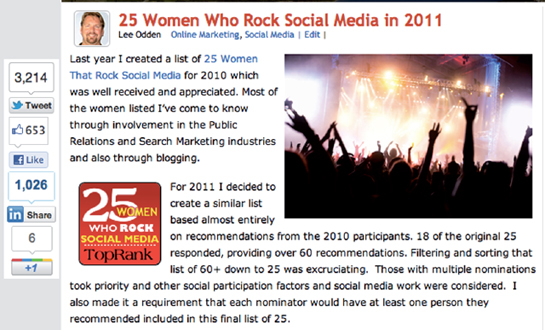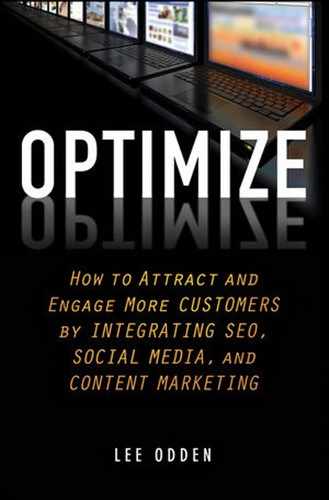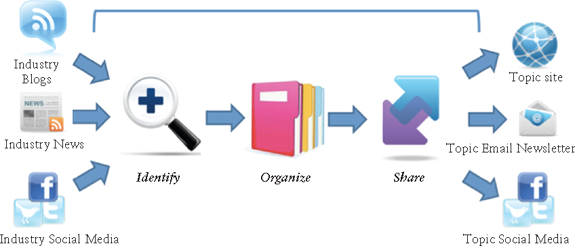CHAPTER 9
Content Isn’t King, It’s the Kingdom: Creation and Curation
Google’s executive chairman, Eric Schmidt, has been quoted as saying, “Every two days we now create as much information as we did from the dawn of civilization up until 2003.”1 That’s a tremendous amount of content, and it represents the overload of information many online citizens experience between social networks, online news, e-mail, and entertainment. But content is what we do online. In fact, 53 percent of time spent on the Internet is directly attributable to content consumption.2 Your prospective clients are consuming content every day. So are journalists, customers, job candidates, industry analysts, investors, and employees. The opportunity to connect with the communities that will help grow your business can be realized with a content marketing strategy that balances both curated and original content.
For an article on content curation, I reached out to a group of my peers who are experts in the content marketing arena and asked for their perspectives on the role of content curation. Here are some of their responses:
Content curation, which can be defined as a highly proactive and selective approach to finding, collecting, presenting, and displaying digital content around predefined sets of criteria and subject matter, has become essential to marketing, branding, journalism, reporting, and social media—often, to mash-ups of all these different and disparate channels.
Rebecca Lieb, Digital Marketing and Media Analyst, The Altimeter Group, and author of Content Marketing
What is Expedia? It’s an aggregation of airline and hotel feeds that then get aggregated to create content. What’s Google? Google is an aggregation of a whole bunch of content. I’m a fan of doing that but the challenge is how can you do it in a way that’s interesting? You have to make a decision: Do you let the machines do the aggregation and the selection or do you let humans do the selection. It’s a huge decision, humans or machines.
David Meerman Scott, Professional Keynote Speaker, best-selling author of The New Rules of Marketing and PR plus several other popular books on digital marketing topics
As more content floods through all aspects of the web (as well as print and online), we’ll need more brands stepping up to make sense of what we really should be paying attention to. Content curation is as important in the content marketing toolbox as is creation. We need both.
Joe Pulizzi, Founder of Junta42 and Content Marketing Institute, coauthor of Get Content, Get Customers and Managing Content Marketing
Just a few years ago, audiences were starved for information and the role of media was to create it. Today, we are drowning in information and the emerging role for media is to filter and organize it. Marketers can build trust with their constituencies by providing focused curation in areas that matter to their constituents. Original content will always have value, but curation is coming to have nearly equal value.
Paul Gillin, consultant, speaker, and author of three books on social media marketing
Most business marketers understand the notion of creating original content, although few feel confident about their ability to execute over prolonged periods of time. When I ask companies about their approach to content curation, I often hear a variety of explanations—and even more questions. Some of the most common questions companies ask about content marketing are answered by digging into the details of how creation and curation can work together. A few examples:
- With so many companies and individuals publishing content online, how do we stand out?
- How can we build thought leadership in our industry with prospects and the media?
- How can we gain SEO benefits efficiently?
- How can new content, along with useful resources we curate, fit within our online marketing mix?
- How do content creation and curation work best together to inspire customers to buy?
When I started blogging late in 2003, my passive objective, outside of learning about blogging as a communications and marketing platform, was to assemble interesting stories and add some of my own commentary. If you had asked me back then why I was blogging, my reply would have been something about building credibility and sharing industry news with staff and clients. Looking back, I was clearly curating content. Not just for friends, but for the online marketing industry at large. Through a combination of speaking events, curation, and original content, our agency was able to attract all of our new clients over the past 10 years without a sales team or buying advertising. (For a sample of our blog, see Figure 9.1.)
FIGURE 9.1 25 Women Who Rock Social Media

How did that happen? Over time, my descriptions of daily news on the blog became more in depth, and, while finding my blogging voice, I entered the world of content creation by writing articles. Those useful, keyword-optimized articles that demonstrated expertise and personality also attracted links, shares, and subscribers to our content, which led to clients like Hewlett-Packard, Marketo, and many other well known brands. Michael Brito, who was a search marketing manager at HP (and is now a senior vice president for social business planning at Edelman Digital), read, subscribed, and commented at TopRankBlog.com for more than six months before hiring our agency. He shared these kind words about me and my blog: “Before I even met Lee, I truly knew his approach to search marketing because I read about it every day. I could see that he was at the top of his game” (Minneapolis Star Tribune 2007).
The “curation to creation” path I’ve described is pretty common among companies that are just starting out with a business blog. Depending on your goals and what customers need to know in order to buy from you, curation is a great starting point. How? I call it the “Oreo cookie tactic.” Set up Google Alerts for a relevant topic and, when something piques your interest, take an excerpt of the article and write your own introduction and conclusion (with proper citation of the source, of course). Your contributions are the cookie part of the Oreo, and the excerpt is the white stuff in the middle. Blogging isn’t the only platform for content curation, of course. In whatever ways ideas are being shared online, there’s an opportunity to curate and create, to filter information and package it in a way that adds value.
A mix of creation and curation certainly worked for me and for many of the companies I’ve worked with over the past ten years. Will it work for you? That’s what this chapter aims to answer.
It’s a bit of a silly question to ask, “Which is better, content creation or curation?” because there are clear benefits to each and for both together. The optimized content marketing plan and editorial calendar you’ve created based on previous chapters should allow for original content creation where it can best facilitate your business objectives. The same guideline applies to content curation. Implement where it makes sense for your approach. My experience is that a mix of the two helps companies achieve a variety of online marketing objectives related to creating awareness, building thought leadership, and attracting new business through search and social media. Ann Handley, chief content officer of MarketingProfs agrees: “Mix curated content with original content, and don’t rely on the curated stuff alone. Content curating is a perfectly good way to extend the content of your own site, but only ‘in addition to’ and not ‘instead of’ your original content.”
To help you decide on the mix of curation and creation that’s right for you, here are some of the common objectives for each.
Content Curation Facilitates These Objectives
- Efficient, topically focused collection of information that appeals to customers looking for a “single source” on a particular topic.
- Grows awareness of your brand as a topical authority based on adding insight to industry commentary.
- Facilitates networking into spheres of influence in your industry. Collecting and sharing content from influential members of your community can get you on their radar, resulting in mentions, links, or even referrals.
- Attracts links from social sources like Facebook and Twitter. Social links can send traffic and influence social and standard search visibility.
- Attracts links from other websites, which can also send traffic and influence better visibility on search engines like Google and Bing.
- Keeps prospects engaged as part of your lead-nurturing efforts.
Content Creation Facilitates These Objectives
- Builds thought leadership through original ideas and insights in your industry category.
- Communicates your brand’s distinct voice, point of view, and personality in a format that you control.
- Facilitates storytelling about your brand’s success in serving customers.
- Provides the material that facilitates movement of readers through your buying cycle based on your content plan.
- Attracts links from other relevant websites, blogs, and social networks to influence search and social media visibility.
- Provides a source of optimized content according to specific customer segments, keyword targets, and objectives.
- Creates source material for others to curate and share, including customers, prospects, employees, journalists, and industry bloggers.
What does a content curation and creation mix look like in action? Let’s say our target persona is Sara, a purchasing manager for a chain of coffee shops that sells fair trade coffee and values doing business in an environmentally friendly way. For Sara, price is a factor, but she’s also very eco-conscious about her suppliers and the products they offer. Through our research, we know that Sara’s values and goals can be translated into search phrases like “recyclable coffee cups” and “eco-friendly coffee supplies.” She’s also interested in social topics via channels like blogs, Facebook, and niche forums such as “sustainability and coffee” and “easy to recycle.”
With a basic understanding of what Sara cares about related to the products she needs to purchase, we can expand search keywords and social topics into a content plan that produces thoughtful, easy-to-find, and easy-to-share information that builds our brand awareness and credibility as a go-to source for environmentally conscious coffee shop supplies. Our content plan could involve curated content to build awareness such as collected news about environmental and fair trade issues related to the coffee industry as well as news about small business, retail business, and the geographic areas in which her company operates. Curated formats might include a news blog with RSS feed, an e-mail newsletter, and user-generated tips. Original content could include thought leadership articles from the CEO of the coffee shop supply company, articles about the company’s advocacy of green commerce, and a series of answers to frequently asked questions about company products sourced from company sales and customer service personnel. Formats for original content might include a resource section about green coffee topics on the website, blog posts, images, and videos.
This combination of curated and original content will help attract and engage the Sara the Purchasing Manager through multiple touch points, including search engines and social networks. Consistency of message, community engagement, and relevant content that’s easy to find on search engines and share on the social web will demonstrate that the coffee shop supply company has a business philosophy congruent with what Sara cares about. The company also demonstrates thought leadership and expertise by providing useful, curated industry news and specific, original stories related to its products and services in a helpful (versus “salesy”) way.
Think about your customer personas and segments. As you review your content plan and what those customer groups care about relevant to your products and services, what types of content would resonate with your target customers? What words would they use to search? What topics would they discuss to find information on social networks? What would inspire them to engage, share, and buy? Keeping in mind what’s relevant for the customer and brand relationship, here is a collection of content sources to consider:
- Engage with your community, and ideas will come out of those interactions. Look for common questions, misinformation to be clarified, and unique stories to share.
- Survey customers, blog subscribers, and social network members to find out concerns, their influences, and their goals.
- Look at popular questions on Quroa, Yahoo! Answers, and LinkedIn Answers relevant to your customer segments. Which questions are asked most often? Which questions are poorly answered that you can add value to?
- Mine your web analytics data for referring search keyword phrases that indicate common questions. Adding a filter by using words such as “how,” “what,” or “why” against the search phrases that delivered traffic to your website could indicate topics that interested customers seek answers to. Try a filter simply by using a “?” to see a broader range of questions that you might want to answer through new or curated content.
- If your website has an internal search engine, look at the search logs for the things visitors are searching for.
- Find out what frontline staffers (e.g., sales and customer service personnel) are being asked most often. This tactic is a gold mine for finding the kind of information your customers are specifically looking for on the search and social web.
- Look at trending websites for seasonality or cyclicality in the demand of search topics related to your products and services.
- Monitor stories in the news that match topics of interest to your customers (aka newsjacking) where your company could be a solution.
- Monitor competitors’ names in social and traditional media for opportunities to position your company as an alternative or to provide a counterpoint.
- Watch for industry reports, studies, and research that you can compile and add commentary to.
- Analyze the content you’ve been publishing for effectiveness; expand the things that are working and modify or reduce the areas that are not.
CONTENT CURATION BEST PRACTICES
Blending a mix of new content with the filtering and management of other useful information streams is a productive and manageable solution for providing prospective customers a steady stream of high-quality and relevant content. There are several good services that facilitate curation tasks, such as Curata, Curation Station, and CurationSoft. (See Figure 9.2.) Software can help, but on its own isn’t the answer. Pure creation is demanding. Pure automation doesn’t engage. Curating content can provide the best of both. Here are several best practices to help you with curation sources, types of content, and where to publish.
Sources of News to Curate
- Industry-specific newsletters sent to you via e-mail
- Links to content and media shared on Twitter, Facebook, StumbleUpon, Reddit, and other social sharing websites
- Google Alerts, Google News, or Google+ Search
- Curation tools: Flipboard, Scoop.it, Storify.com
- Real-time search engines: Topsy, socialmention.com
- Niche topic blogs
- News aggregators: Alltop, popurls, Techmeme
- Bookmark and/or subscribe to updates from industry news, magazine, and blog websites
- Press release distribution services like PRWeb, PRNewswire, or Marketwire
- Monitoring competitor websites for mentions of their brand terms through Google Alerts and social media monitoring tools (e.g., Trackur or Radian6) to see what kind of curation tactics they’re using
Types of Content to Curate
- Useful resources relevant to your target audience: blogs, news, training, tips, networking, and industry events.
- Content created by influential people of importance to the target audience
- Statistics, research, and reports
- Compelling or provocative industry news
- Videos: YouTube, Vimeo, Viddler
- SlideShare presentations or search Google.com for .ppt file types
- White papers, e-books, and case studies
- Infographics and other data visualizations
- Tips, how-tos, and best practices
- Creating short lists of tips according to keyword themes
- Compiling large collections of resources according to topical theme
- Aggregating the best comments from other blogs or your own blog
- Running surveys, polls, and contests that result in content
Where to Publish Curated Content
- Company blogs
- E-books
- E-mail newsletters
- Social media channels
- Contributed articles or blog posts to industry sites
- Niche microsite dedicated to a specific news category
These are just a few suggestions, and the best ideas for content creation and curation will come from a specific analysis of your own customer groups and industry. The key is to do the homework of understanding what motivates your customers and to assemble a compelling mix of curated and original content to inspire them to engage and buy. Be thoughtful about the usefulness of the content you assemble, create, and promote. Empathize with your customers’ interests and goals so you can properly optimize content for customers, search engines, and to inspire social media sharing.
It is my hope that these ideas have sparked your imagination for how you can leverage a mix of content creation and curation to build awareness and thought leadership for your brand, to attract links and traffic, and to stand out among the growing sea of online content. With a strong foundation of content marketing principles, now we can turn to leveraging our keyword research for best practices in content optimization and SEO copywriting.
1. What are your three most important objectives related to content marketing, and what role can content creation or curation play in your content marketing strategy to achieve them?
2. For which goals will you curate content? Which will require original content?
3. Identify 3 to 4 sources of content for curation. Start tracking topics relevant to your target audience and develop a process for identifying key topics for curation.
4. Set up Google Alerts or a special monitoring profile using your favorite social media monitoring tool for topics relevant to your audience and the business content marketing strategy. Find stories that you can use with the Oreo cookie approach to blogging and curation.
Notes
1. Mg Siegler, “Eric Schmidt: Every 2 Days We Create As Much Information As We Did Up To 2003,” TechCrunch, August 4, 2010, http://techcrunch.com/2010/08/04/schmidt-data/.
2. “AOL Research: Content Is The Fuel Of The Social Web,” AOL, April 28, 2011, http://corp.aol.com/2011/04/28/aol-research-content-is-the-fuel-of-the-social-web/.

